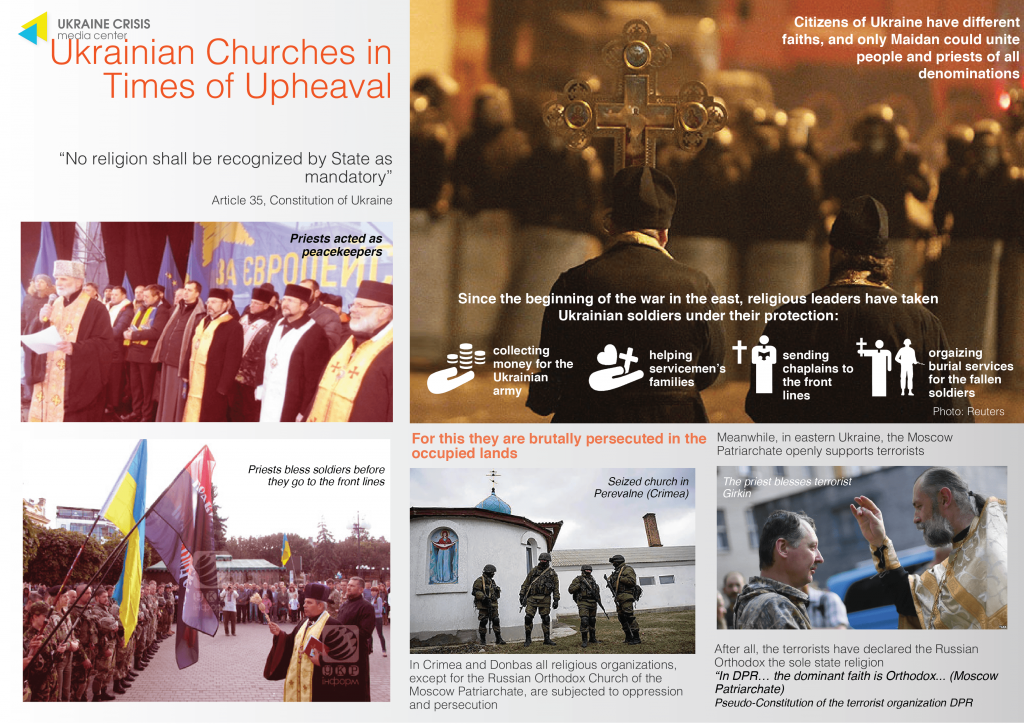Religion has played a central role in the conflict in Ukraine, serving as an adept tool for Russian President Putin’s machinations in the Donbas. Russian Orthodoxy is the official religion of the self-declared state of Novorossiya in eastern Ukraine. A militia unit called the Russian Orthodox Army fights alongside other pro-Russian units on Ukrainian soil. Other religious groups – Protestants, Greek Orthodox practitioners, and Muslims – became targets of a virulent campaign to ensure Moscow’s religious dominance in territories under Russian or pro-Russian control.
Vladimir Putin has marketed the conflict to the Russian people as a civilizational confrontation — that of the historical Russian and east Slavic world (Russkiy mir) versus the degenerate forces of the West and its allies. By alleging threats to Russia’s religious and linguistic compatriots in neighboring countries, Putin invokes the right to intervene in their protection. According to this logic, religious minorities in Russian-controlled territories are a threat to both Moscow’s religious, and by extension political, dominance on occupied land. This is not to say that most pro-Russian fighters in the Donbas are particularly devout believers. The role of religion in the conflict serves a higher purpose — the consolidation of Russian political influence.
In this way, pro-Russian militants can simultaneously sport communist symbols of the atheist Soviet regime and Orthodox crosses without apparent contradiction. Both represent Moscow’s political dominance and opposition to a West that is portrayed as morally degenerate and aggressive toward Russia. Both the Soviet Union and the spread of Orthodox Christianity from Kyiv to the Pacific remain central to the Putin-approved historical memory of Russian greatness.
Unsurprisingly, elements of Ukrainian society that contradict this narrative are a threat. Donbas natives who support a united Ukraine in opposition to pro-Russian imperialist agenda are the most immediate targets. They not only challenge political hegemony in militant controlled territory, but are living proof that the ideology of the “Russkiy mir” has significant opposition, even the demographics that are supposed to be most receptive to the campaign. The public humiliation, beatings, and torture of those suspected of opposing armed militants has been picked up by foreign news services, and was exemplified by the New York Times piece on the plight of Donetsk resident Irina Dovgan, who was publicly humiliated, tied to a post, and attacked.
Practitioners of Protestantism and Christian sects besides from the Russian Orthodox Church under the Moscow Patriarchate are other targets. The report released by the UN High Commissioner for Human Rights on August 17 documents attacks on non-Orthodox Christian groups in their territory. Protestant organizers of a “Prayer Marathon” in downtown Donetsk were detained over the summer because of the event. One priest was beaten and tortured. The report noted that their treatment in detention was aggravated because of their religion, and that Russian Orthodoxy is the only permitted sect in separatist-controlled territory. Roman Catholic and Greek Catholic leaders allege similar kidnappings and beatings. Perhaps most alarming was the unsolved murder of four young evangelical Protestants in the former rebel stronghold of Sloviansk. The four were removed from a church service by militia, their cars stolen. Later, their bodies were discovered in a grave with other victims. Although the motive for the crime is still unknown, some in the Ukrainian government and foreign media sources suspect that the victims’ faith could have been a factor.
Putin’s abuse of religion in the Ukrainian crisis is gradually gaining attention in foreign capitals and international media. Andrew Bennett, Canada’s religious freedom ambassador, visited Ukraine last week. Bennett has publicly criticized Putin for facilitating the persecution of religious minorities in eastern Ukraine and Muslims in Crimea, including the firebombing of churches and kidnapping of religious officials. In the Canadian online publication, The Canadian Press, Bennett claimed that the persecution of religious minorities in Ukraine was ultimately political and rooted in Russian nationalism. “It’s a narrative drawn from the 19th century, not the Soviet period. This is a narrative building upon Russian nationalism that is rooted in Orthodoxy,” he stated.
The manipulation of religion in the current conflict is one that is often overlooked or ignored. An article published recently in The New York Times, Rebels in Eastern Ukraine Dream of Reviving Soviet Heyday, correctly observed the pro-Russian militants’ nostalgia for past Soviet glories. The article missed, however, the deeper issue of the perception of Russian greatness and exalted place in the world. Those who potentially challenge that narrative are vulnerable to persecution and abuse.
Chris Dunnett, Ukraine Crisis Media Center


